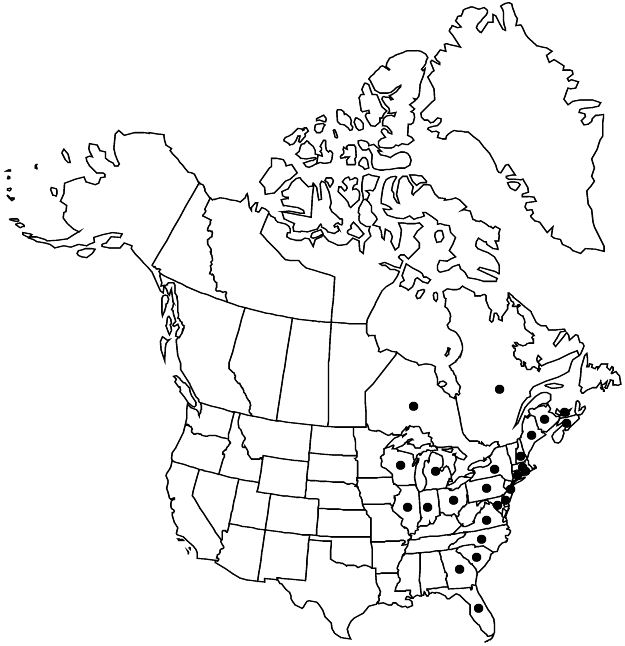Euphorbia polygonifolia
Sp. Pl. 1: 455. 1753.
Herbs, annual, with taproot. Stems usually prostrate, occasionally ascending, 5–30 cm, glabrous. Leaves opposite; stipules usually distinct, occasionally connate basally (distal portion of stem), triangular-subulate, entire or divided, 0.8–1.5 mm, glabrous; petiole 1–3 mm, glabrous; blade oblong, linear-oblong, or linear-lanceolate, 5–16 × 2–4 mm, base slightly asymmetric, obtuse or subcordate, margins entire, apex obtuse, often mucronulate, surfaces uniformly green or reddish tinged, glabrous; venation obscure. Cyathia solitary or in small, cymose clusters at distal nodes; peduncle 0.5–5 mm. Involucre obconic-campanulate, 1.2–1.7 × 1–1.4 mm, glabrous; glands 4, occasionally rudimentary, green-yellow to tan or orange-tinged, occasionally shortly stipitate, usually broadly oval to subcircular, sometimes figure eight-shaped, shallowly cupped, 0.1–0.3 × 0.2–0.4 mm; appendages absent or rudimentary. Staminate flowers 5–14. Pistillate flowers: ovary glabrous; styles 0.7–1 mm, 2-fid 1/2 length. Capsules broadly ovoid, 3–3.5(–4) × (2–)2.4–3 mm, glabrous; columella 2–3 mm. Seeds ashy white, wedge-shaped to slightly ovoid, weakly dorsiventrally compressed and elliptic-terete to bluntly subangled in cross section, back strongly rounded, face slightly rounded, (2–)2.2–2.8 × 1.6–1.9 mm, smooth or minutely pitted, with smooth brown line from top to bottom on adaxial side.
Phenology: Flowering and fruiting early summer–fall.
Habitat: Sandy maritime and freshwater beaches and foredunes.
Elevation: 0–200 m.
Distribution

N.B., N.S., Ont., P.E.I., Que., Conn., Del., Fla., Ga., Ill., Ind., Maine, Md., Mass., Mich., N.H., N.J., N.Y., N.C., Ohio, Pa., R.I., S.C., Va., Wis.
Discussion
Euphorbia polygonifolia is native to coastal beaches and dunes along the Atlantic Ocean from the maritime provinces of Canada south to northern Florida. The species also occurs disjunctly along the shores of the North American Great Lakes. Euphorbia polygonifolia was native to Quebec but is now considered extirpated from the province. It has apparently been introduced in Europe, but it is unclear if it has persisted there (L. C. Wheeler 1941). Immature individuals of this species can be somewhat difficult to distinguish from E. bombensis where their ranges overlap (Virginia to northern Florida). Where they occur together, E. polygonifolia tends to be a pioneer species on the upper beach and foredune front, whereas E. bombensis tends to inhabit areas behind the foredune (R. D. Porcher and D. A. Rayner 2002). Euphorbia polygonifolia can be distinguished also by its larger capsules and larger, wedge-shaped to slightly ovoid seeds.
Selected References
None.